Scott’s Scale hardtail cross-country race bike has been given a 2023 update, focused on weight savings, fresh geometry and a series of refinements.
In a bid to eke out marginal performance gains and create a razor-sharp ride without compromises, the brand has concentrated on the details for this iteration of the Scale.
Thanks to a carbon fibre monocoque front-triangle construction and special zones – one for weight saving, the other for stiffness – Scott claims it has upped efficiency and rigidity without increasing weight over the outgoing model.
Elsewhere, small refinements and their respective weight savings all add up.
Among other things, the rear dropout has been redesigned, and the bottle cage boss inserts are made from polymer (a type of plastic), both said to reduce weight.
I was given the £13,999 / €13,999 Scale RC SL to test, which sits at the top of the five-model line-up.
The large test bike without pedals tipped the scales at 8.93kg, a weight worthy of the Scale’s Nino Schurter and Kate Courtney racing pedigree and lofty price tag.
Scott Scale RC SL frame
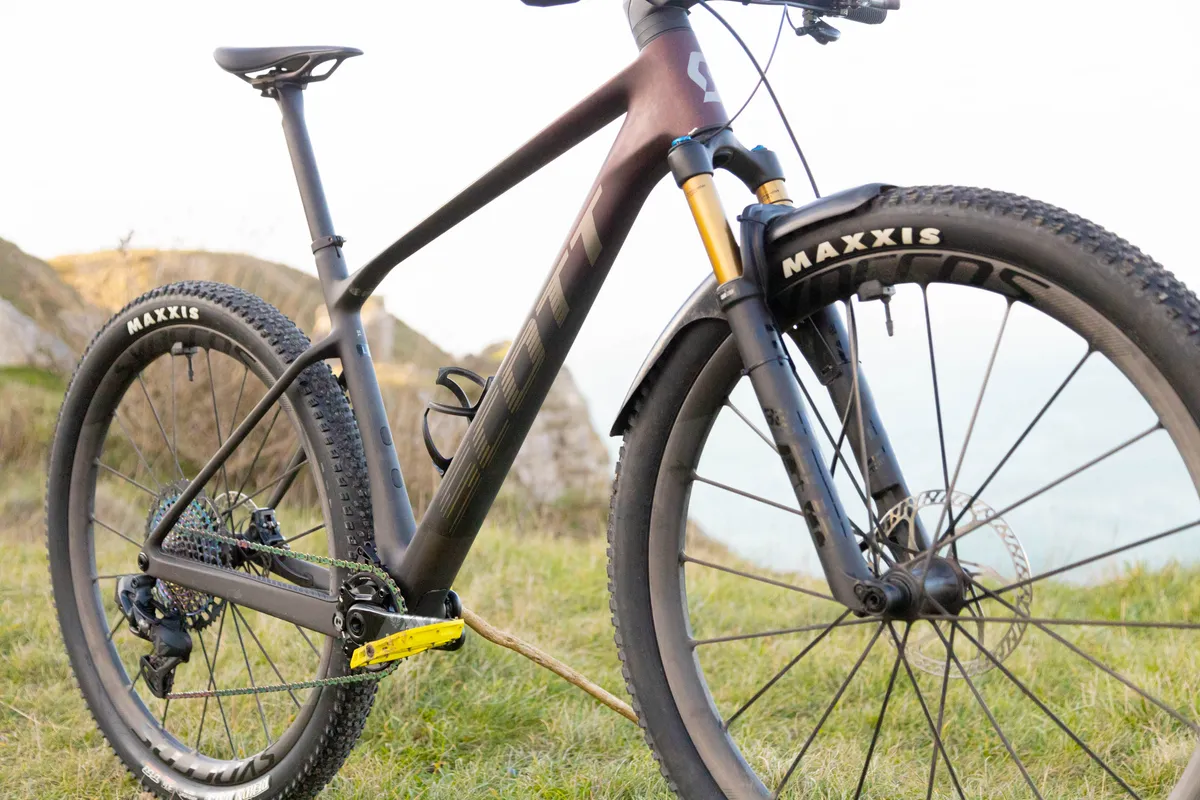
Although all the new Scale frames have a monocoque construction (more on this shortly), the RC SL version uses Scott’s most advanced HMX-SL carbon fibre, the HMX standing for ‘High Modulus Extreme’.
HMX-SL uses T1000G carbon fibre, which is claimed to be the “world’s highest tensile strength fibre” and is laid using a “carbon nanotube reinforced epoxy resin”.
The resin’s formula is claimed to improve the carbon’s strength perpendicular and off-axis to its layup direction.
Ultimately, this means the Scale’s frame is made from less material – because the material used is stronger and stiffer – which saves weight without making compromises elsewhere.

HMX-SL tube thicknesses can be as low as 0.8mm, compared to 1mm for the HMX material.
A frame made from HMX-SL carbon fibre is 8.5 per cent lighter than the same frame made from HMX carbon, according to Scott.
Scott says the frame of the HMX-SL I’ve tested weighs 847g (size medium, with hardware), compared to 912g and 1,013g for the heavier HMX and HMF versions respectively.
Thanks to advanced construction techniques, the Scale’s front end is made from one single laid-up section of carbon, where only one mould is used. This means there are fewer sections or pieces of frame that need to be bonded together, creating fewer “junctions” to use Scott’s terminology.

The Scale RC is made from three sections of carbon, with the other two found in the rear triangle.
According to Scott, this construction technique can be attributed to an “increased level of efficiency”, but with fewer weight penalties.
Its monocoque construction is claimed to absorb forces – whether from pedalling or impacts from the trail – as a whole, rather than in segments.
Zoned construction

The frame’s construction has been split into two ‘zones’. The upper half (top tube, seat tube and seatstays) has been tuned to be light, and is complemented by the stiffness zone (head tube, down tube, bottom bracket and chainstays).
Its stiffness zone is claimed to help maintain stiffness for efficient pedalling and ride feel, the characteristics Scott says are ideal for a cross-country hardtail.
To blend these characteristics, different carbon fibre weaves have been used in the different portions of the frame, where the stiffness zone uses a higher number of high and ultra-high modulus fibres.
Its lightness zone uses fibres with a “high ductility”, according to Scott, which adds flexibility and lowers weight.
Attention to detail

Getting onto the smaller details, Scott has redesigned the Scale’s rear non-driveside dropout.
Thanks to a hollow construction and small insert, the rear axle now sits flush with the outside of the frame.
Scott claims not only has this helped to shave 7.5g from the dropout, but it means the rear triangle can be narrower, losing a further 20g.
On a quest for further weight savings, Scott has swapped out the previous-generation bike’s metal bottle cage inserts for polymer ones, but only on the HMX-SL frames. The inserts can be removed easily to provide a clean look, or replaced if they get damaged.
Next on the brand’s hit list is the brake mount, which now uses direct-mount post bosses for a 160mm rotor. This shaves an additional 14g from the frame’s weight.
Benefitting from a redesign is the integrated chain guide that now sits flush with the frame. The small, minimalist attachment bracket can be removed, and the hole it leaves plugged.

The bike’s cables are routed internally through the angle-adjusting Syncros headset, although this is only for the rear brake cable on this model, thanks to the lack of a dropper post and SRAM AXS electronic wireless shifting.
Finally, there’s a ‘service door’ on the underside of the down tube above the bottom bracket. Scott says this should help speed up and make maintenance easier, for tasks such as routing cables internally.
Scott Scale RC SL geometry
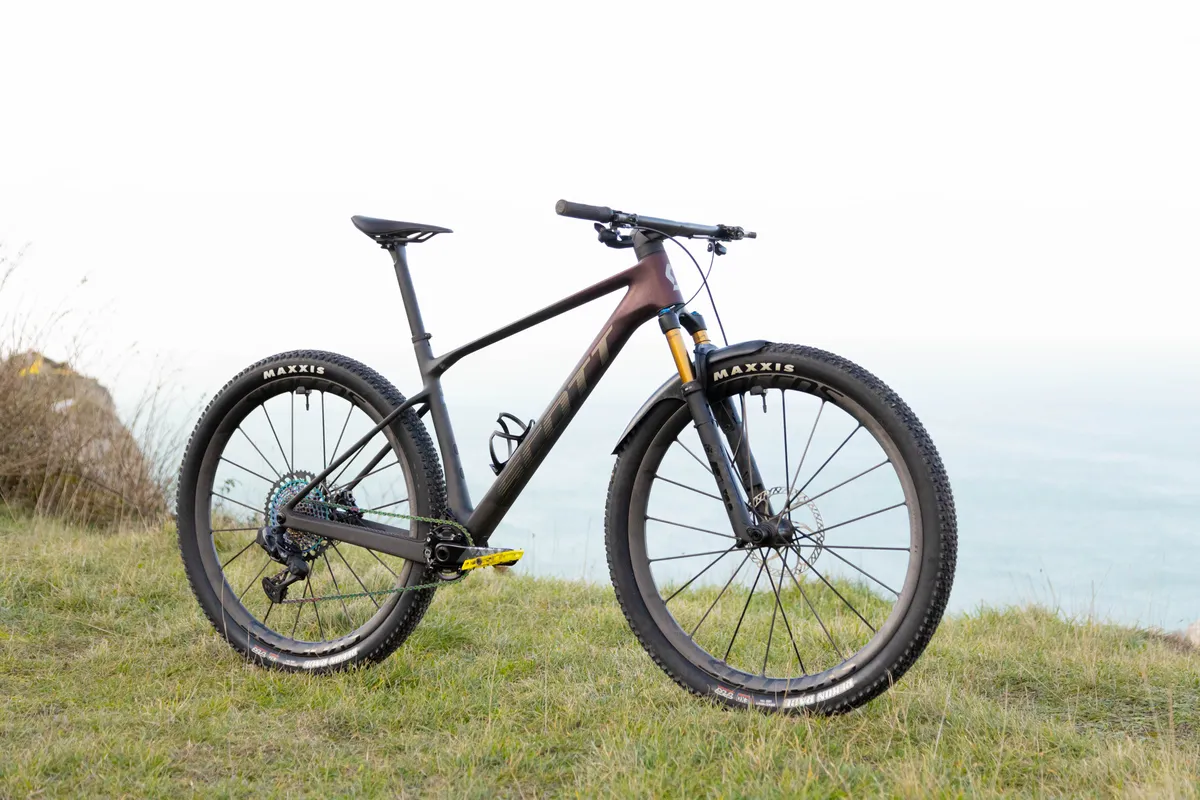
Rather unsurprisingly, the Scale has been given the lower, slacker and slightly longer treatment. It takes inspiration from Scott's full-suspension XC race bike, the Spark, and follows trends set by a host of other bikes on the market.
Its geometry was carved out with help from Scott’s XC race team, which includes athletes such as Nino Schurter and Kate Courtney.
Scott was keen to point out the new Scale needs to retain the “characteristics of a thoroughbred XC hardtail”.
Key figures include a 67.9-degree head tube angle, that, thanks to an angle-adjust headset, can be raked out by 0.6 degrees to 67.3 degrees.
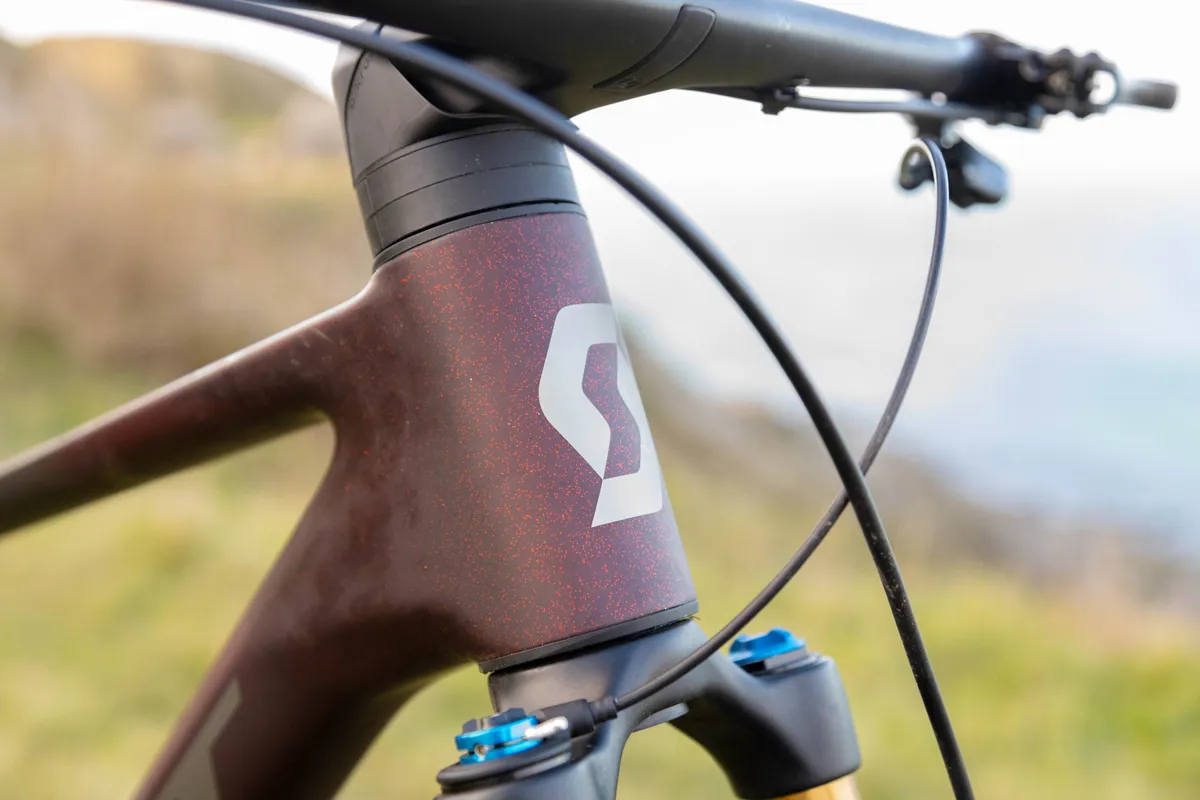
A relatively steep 75.4-degree seat tube angle also features.
Reach figures span from 418.5mm for the size small up to 491.2mm for the extra-large. Top tube lengths start at 575mm and lift to 656.5mm.
The large test bike I’ve been riding has a 463.6mm reach and a 626mm top tube. Elsewhere, it has a 425mm chainstay – which is the same across all sizes – and a 1,158mm wheelbase.
| Size | Small | Mediun | Large | Extra-large |
|---|---|---|---|---|
| Head angle (degrees) (steep/slack) | 67.9/67.3 | 67.9/67.3 | 67.9/67.3 | 67.9/67.3 |
| Seat tube angle (degrees) | 75.4 | 75.4 | 75.3 | 75.3 |
| Seat tube length (mm) | 390 | 440 | 480 | 530 |
| Effective top tube length (mm) | 575 | 600.2 | 626 | 656.5 |
| Bottom bracket height (mm) | 313 | 313 | 313 | 313 |
| Standover height (mm) | 752 | 781 | 800 | 835.1 |
| Wheelbase (mm) | 1,105.40 | 1,131.10 | 1,158 | 1,189.40 |
| Chainstay length (mm) | 425 | 425 | 425 | 425 |
| Stack height (mm) | 600.3 | 604.9 | 618.9 | 628.1 |
| Reach (mm) | 418.5 | 442.3 | 463.6 | 491.2 |
The bottom bracket sits at a low 313mm, with a 62mm drop beneath the axles.
While the figures are certainly modernised from the outgoing Scale, they’re still very representative of the numbers used at the sharp end of XC marathon racing.
Scott Scale RC SL specifications

The no holds barred, top-of-the-range Scale RC SL is decked out in components that span from made-in-Germany boutique through to high-tech carbon fibre wonders.
Up-front is Fox’s 32 Step-Cast Float Factory fork. It's fitted with the FIT4 damper with low-speed compression and rebound-damping adjustment and a three-position remote lockout adjuster, called RideLoc 2, which is made by Scott.
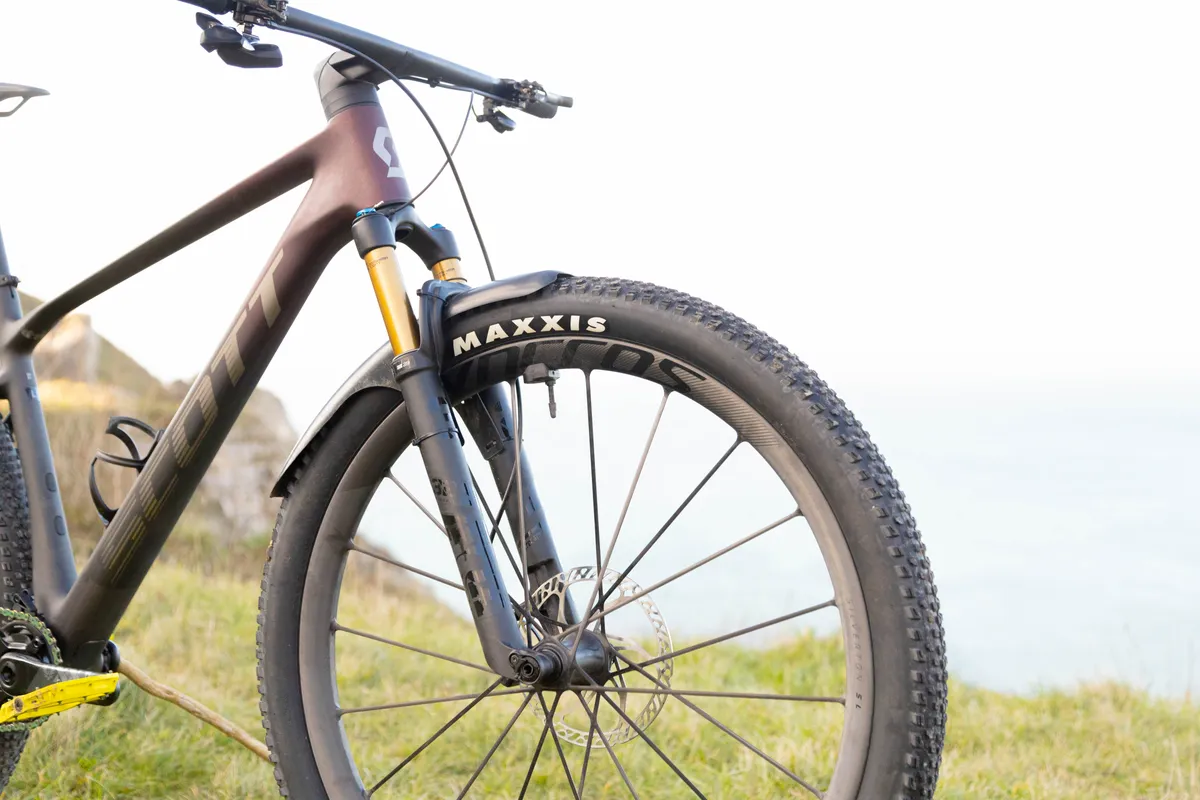
Fox's fork pivots on a Syncros angle-adjust headset. This features a port for internal cable routing with space for a brake hose, dropper post and derailleur cable, although this model only makes use of the rear brake hose routing.
The brakes are supplied by Germany’s Trickstuff. The Piccola Carbon stoppers have a carbon fibre lever blade, which controls a Dächle Ultra-Light two-piston caliper. A 180mm rotor features up-front, and there’s a 160mm version on the rear.
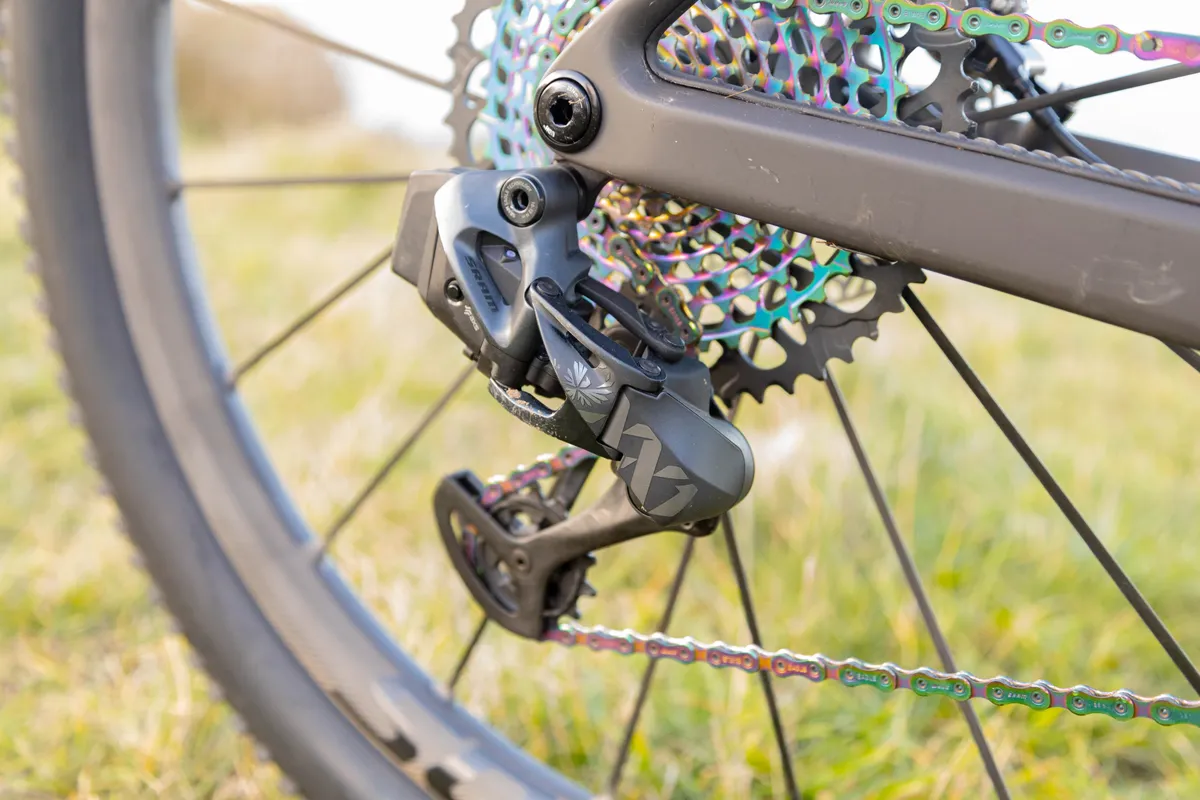
SRAM’s XX1 Eagle AXS groupset takes care of drivetrain duties, and includes a Quarq chainring power meter. The AXS controller mounts to the Trickstuff brakes using a Matchmaker adaptor.
The rest of the bike’s kit is supplied by Scott house-brand Syncros, but that doesn’t mean there’s a lack of quality.
It’s fitted with the mightily impressive Silverton SL2-30 CL carbon fibre one-piece wheels, where the spokes, rims and hubs are constructed from a single piece of carbon fibre.
These are installed with Quarq’s wireless tyre pressure monitoring system, TyreWiz, and are wrapped in Maxxis’ Rekon Race 29x2.4in EXO tyres, front and rear.

Continuing the theme of all-in-one components, the Syncros Fraser iC SL XC Carbon bar and stem are present. These are 740mm wide, have a minus 12-degree rise and an 8-degree sweep.
Elsewhere, there’s a Syncros Duncan SL carbon seatpost and Belcarra SL seat, with carbon fibre rails.
This lot will set you back £13,999/€13,999, and the size-large bike weighs 8.93kg without pedals.
Scott Scale RC SL ride impressions

I had a limited amount of time on the Scale ahead of the launch, but managed to ride on my home trails in Scotland’s Tweed Valley, covering routes that are potentially going to be used for the upcoming 2023 cross-country marathon world championships.
I also managed to spend some time on the bike on the trails of my youth in Dorset, riding flat-out bridleways in the rolling countryside and tight, twisty trails in a local forest.
Scott Scale RC SL setup
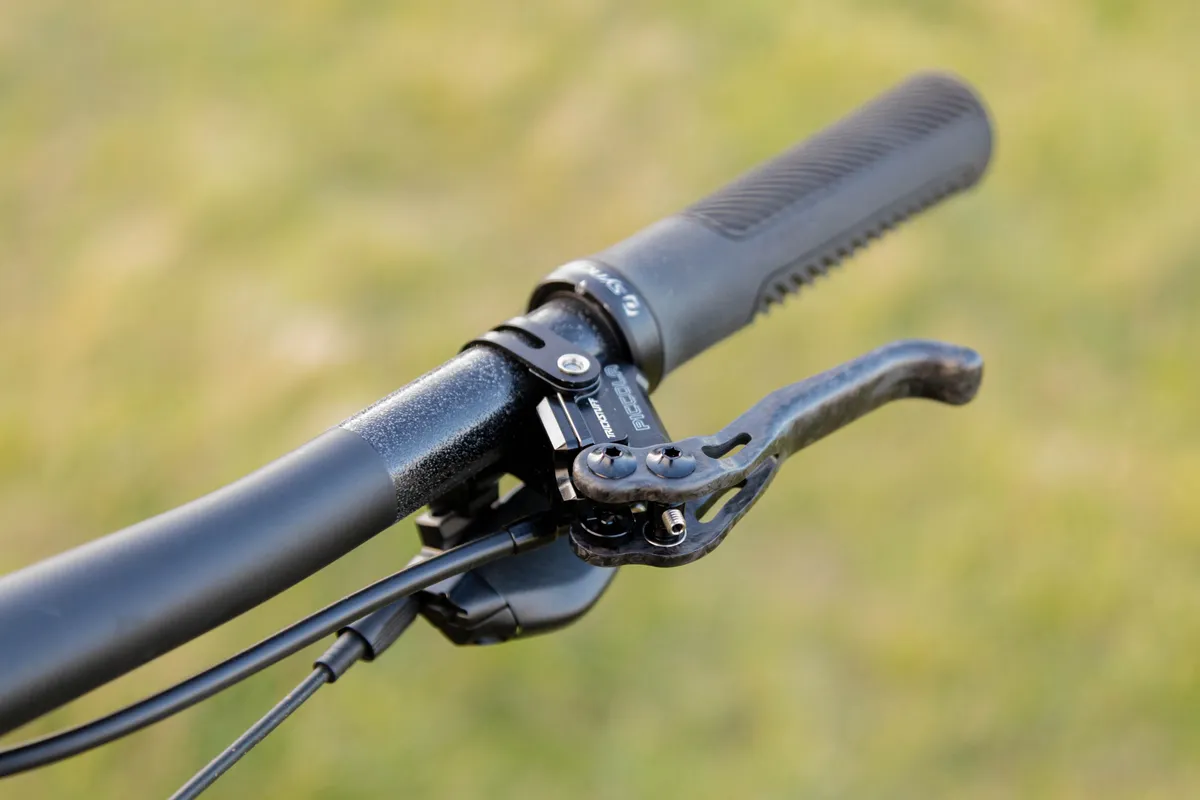
Setting up the Scale RC SL was relatively straightforward.
I inflated the Fox 32 air spring to 84.5psi, Fox’s recommended pressure for my 76kg kitted-up weight and fully opened both low-speed rebound and compression adjusters.
I connected the Quarq power meter and TyreWiz, and AXS derailleur and shifter to the SRAM AXS smartphone app. I inputted my preferred tyre pressures (25psi front, 27psi rear), and zeroed the power meter before each ride.
Getting the Trickstuff brakes, AXS controller and RideLoc 2 installed and set to my preferred positions wasn’t as easy as I hoped. Multiple Allen and Torx key sizes were needed to adjust and install each of the parts, and the AXS controller and RideLoc 2 needed to be removed entirely to access the brake lever’s band clamp bolt.
The brake lever’s reservoir and short lever blade made adjusting them outboard enough for my tastes impossible with the stock grips. The reservoir contacted the grips before I could get them set correctly, however other riders might not suffer from the same issue.

Despite the headset-routed cables, adjusting the Syncros headset’s angle position was fairly straightforward. The upper and lower headset cups need to be turned through 180 degrees to swap between the two settings.
I managed to do this without a bike stand, and, at a push, it could be done in a car park, although doing it where mud and other contaminants won’t enter the internals of the headset is preferable.
Scott Scale RC SL climbing performance

Point the Scale uphill and it's brutally fast and efficient; rider inputs are quickly, precisely and rewardingly converted into forward motion.
Reaching top speeds on smoother, undulating terrain requires a remarkably small amount of effort and the highest cassette sprockets are the most frequently used.
Its low weight figure means as gradients steepen, less effort is required to maintain higher paces when hauling to the top of a climb.
The rewarding relationship between effort and speed eggs you on to ride faster and pedal harder. Although this is an energetic way of riding, and can be tiring over longer periods, it’s perfectly suited to the Scale’s intended high-intensity use.

Smooth operator
That super-efficient feel isn’t accompanied by an uncompromisingly harsh and bone-rattling ride, however.
Pedalling hard over rough terrain, such as baked-on ripples caused by tractor tyres, doesn’t cause the back wheel to skip about and lose traction, and power can still be transmitted through the back wheel.
This is echoed in its seated comfort. Riding rough terrain while seated isn’t compromisingly uncomfortable, making it possible to stay on the saddle for longer. This helps conserve energy for strategic injections of pace.
Thanks to a generally smooth ride, the Scale does a commendable job of isolating the worst trail chatter from the rider; grip is abundant, and fatigue limited.

Getting the back wheel to slip and lose traction on steep inclines is tricky. The Scale exudes composure and has plenty of traction.
On those very steep climbs, the frame’s impressive balance between stiffness and smoothness is enhanced by its low-slung front end and overall geometry.
Aggressive poisitioning
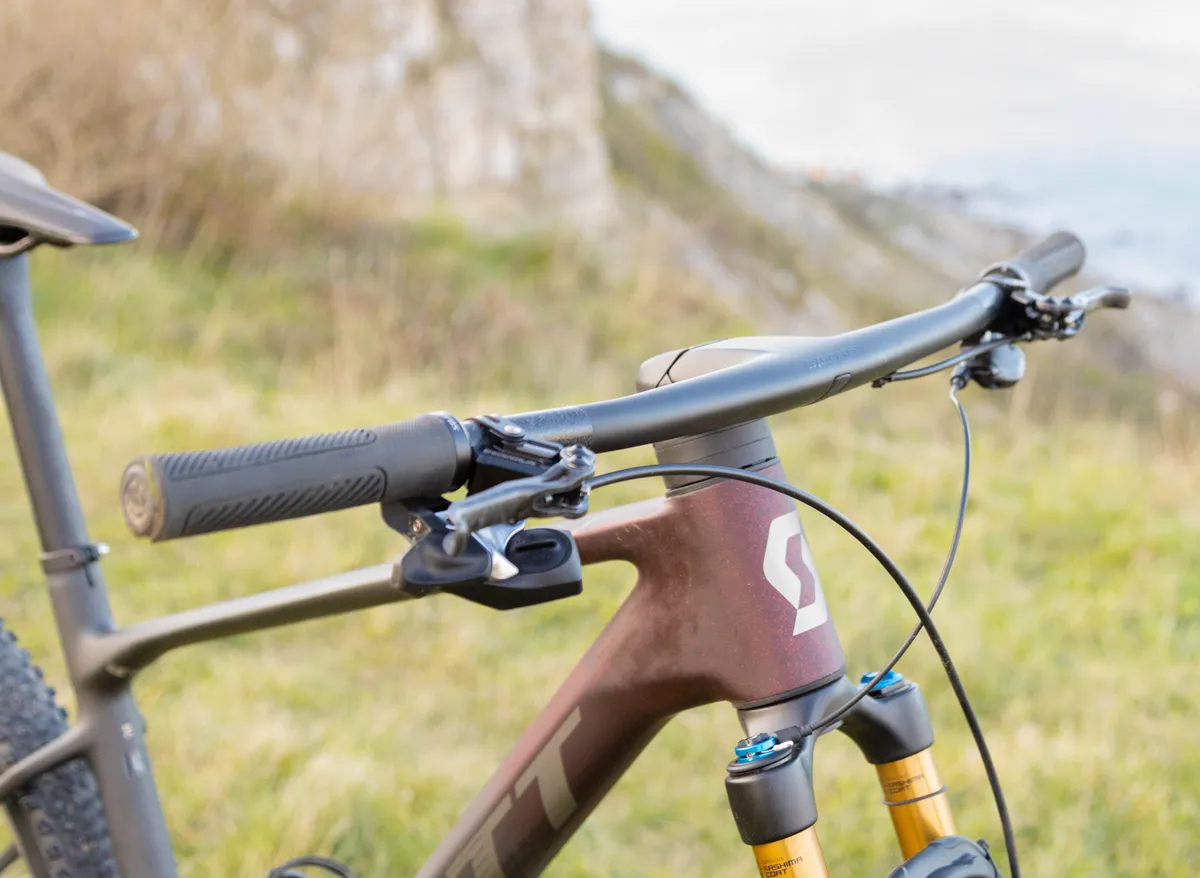
Although the low bars, thanks to their minus 12-degree rise, create a front-bias weight distribution, the shorter chainstays mean the back is never far away from your centre of mass.
This sets you in an aggressive position, where digging deep and lowering your shoulders towards the bars feels rewarding rather than awkward.
That position also helps to spread your weight evenly across the bike’s chassis and wheels, where front-wheel lift or rear-wheel spin need to be initiated.
Weighting the front end of the bike feels totally natural and is helped by the relatively steep seat tube angle when you’re seated.
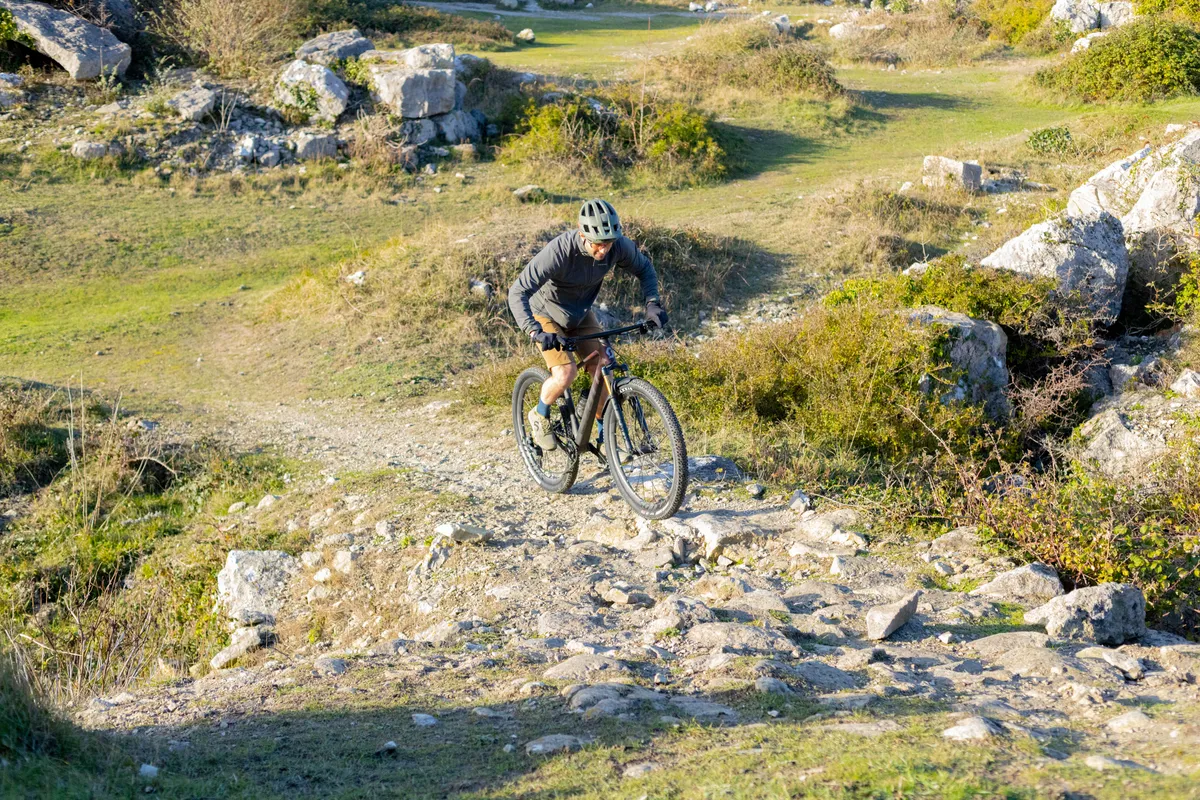
Although I preferred to angle the nose down and push the saddle as far forward in the rails as I could, riders on flatter terrain might not need to do this.
Race-focused tyre tread patterns mean the Rekons hook up well in dry or hardpack surfaces (regardless of weather conditions), but come unstuck in softer and gloopier mud.
The balance between rolling speed and grip is always going to be a fine art on an XC race bike, and Scott has opted to swing the pendulum in favour of speed.
There’s little that gets in the way of the Scale when heading uphill, thanks to its addictive blend of speed and efficiency, agility and comfort.
Scott Scale RC SL descending performance

Despite Scott’s attempts to dull the razor-sharp XC-focused edge of the Scale with a slacker head tube angle, a steeper seat tube and longer figures elsewhere, it still lands itself squarely in the seat up, bar down aggressive cross-country domain.
But by no means is that a bad thing.
An absolute blast
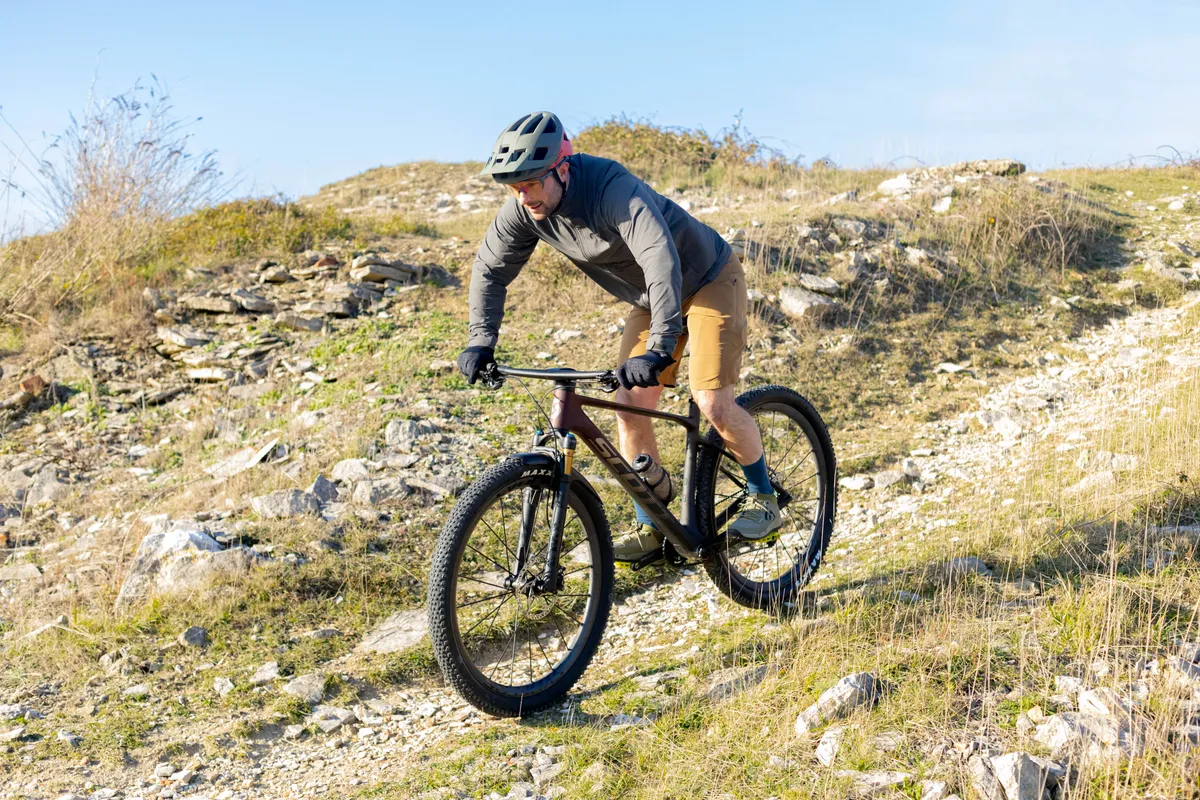
Hauling down long, fast but not hugely technical descents – such as those found on XC marathon racetracks – the Scale is totally at home.
That smooth, grip-rich ride on the ascents is ever-present on the descents, where bumps and trail chatter are successfully numbed.
Its low-slung front end and jacked-up saddle don’t impact descending performance or speed on these types of trails, either.
In fact, the hand-to-feet relationship is balanced, creating good levels of stability and control on fast, rougher terrain.

Speed is easily accessible on less techy trails, and the pace the Scale is comfortable rumbling along at is impressive.
This makes it a hugely enjoyable bike to ride, where the higher the velocity, the more exhilarating and rewarding it is to ride.
Fast-rolling tyres double down on acceleration, but this is at the detriment of some traction.
A more nervous side
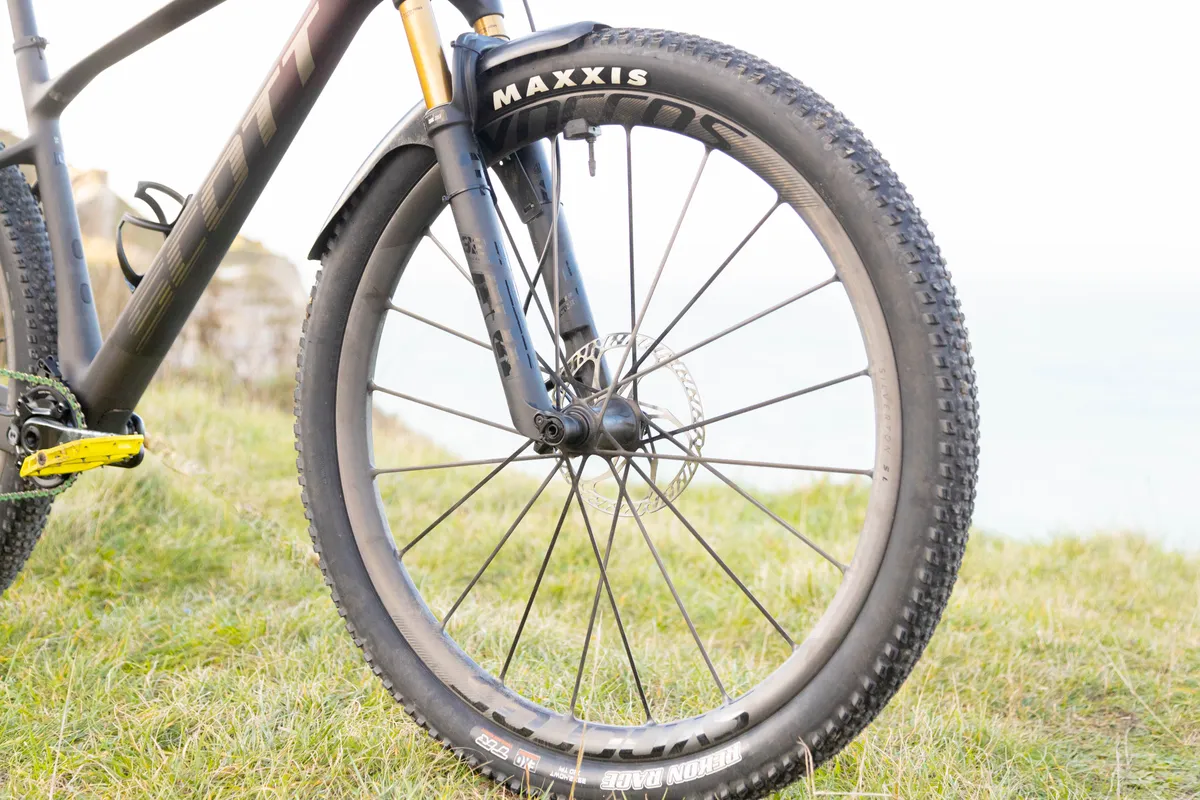
Despite the control afforded by the hand-to-feet relationship, this does have its limits.
Tackling black-graded trail centre descents shows a more nervous side to the Scale.
Multiple factors contribute to this, the biggest of which is the saddle height and lack of dropper post.
Riding down small drops or steps, the high saddle tends to kick up, contacting your backside. This pitches your weight further onto the already low-slung front end, because the bike is unable to move about beneath your body without contacting it.
This creates a nervousness in technical terrain and stops you from coming off the brakes and letting the bike run on faster.
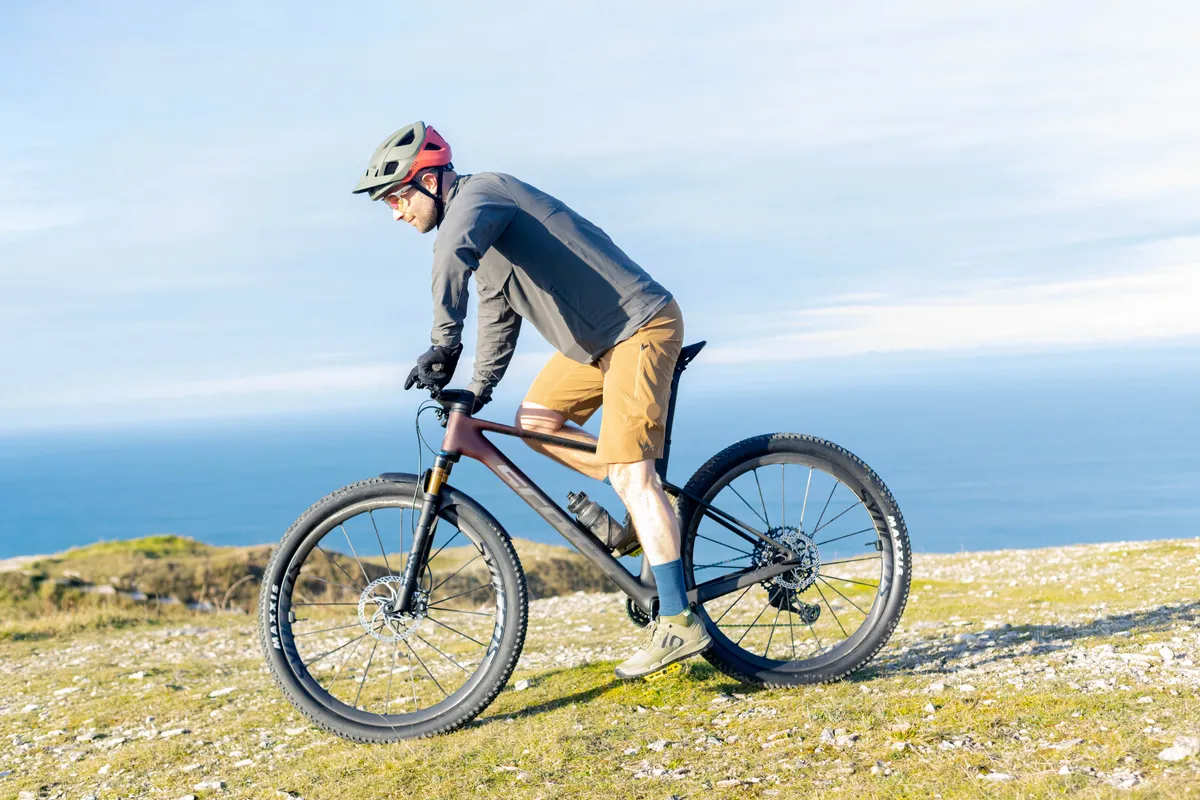
Lowering the seat manually all but cures this issue, and with the seat fully dropped in the frame the Scale edges into downcountry bike territory, especially with the head tube angle set to its slacker, 67.3-degree position. Its handling is fun and engaging, but also controlled and relatively calm.
Having to stop before and after every descent to lower and raise the seat manually seriously interrupts flow and speed, arguably defying the bike’s objective of covering ground quickly.
Some would argue a dropper post is incongruous with the bike’s lightweight persona, but it would add so much value to the ride that I’d take the weight penalty.

Unfortunately, not a single model in the new Scale range is specced with a dropper post from the factory (even this £13,999 version), so if you’re looking for that added performance an aftermarket upgrade will be required.
Adding to the formula is the well-damped Fox 32 Step-Cast fork. Despite its lightweight lowers and narrow uppers, it has impressive steering accuracy and was tricky to overwhelm even when loaded up with my weight on steeper, stepped descents.

Scott Scale RC SL early verdict
The changes Scott has made to the Scale bring it right up to date.
Slacker, more modern geometry means it’s more capable than ever, all without tainting the race-focused ride and highly tuned, efficient chassis.
Speed-obsessed riders who want to charge about on both the ups and (most of) the downs will love the way it rides.
Even if you’re not a speed addict, you’re still going to enjoy riding the Scale. That geometry extends its scope into light trail riding, and with a few choice upgrades – such as a dropper post – it would be well suited to an even broader gamut of terrain types.
This model will be prohibitively expensive for some, but the low weight, parts list and impressive ride make it a compelling purchase for those who can afford it.
However, more time is needed to really pore over the details, and to find out how it performs when tested back-to-back against competitors such as Specialized’s Epic and Trek’s Procaliber.
Product
| Brand | scott |
| Price | 13999.00 EUR,13999.00 GBP |
| br_whatWeTested | Scott Scale RC SL |
| Weight | 8.9300, KILOGRAM (Large) - Large, without pedals |
Features
| Fork | Fox 32 Step Cast Float Factory, FIT4, 3 position lockout |
| br_stem | Syncros Fraser iC SL XC Carbon bar and stem, 740mm |
| br_chain | SRAM XX1 Eagle |
| br_frame | HMX SL Carbon fibre |
| Tyres | Maxxis Rekon Race EXO TR WT 29x2.4in (f &r) |
| br_brakes | Trickstuff Piccola Carbon Disc levers with Trickstuff Dächle Ultra-Light callipers, 180/160mm rotors |
| br_cranks | SRAM XX1 Eagle, Quarq power meter, 32t |
| br_saddle | Syncros Belcarra SL Regular 1.0 carbon |
| br_wheels | Syncros Silverton SL2-30 CL |
| br_headset | Syncros Acros angle adjust |
| br_shifter | SRAM XX1 Eagle AXS |
| br_cassette | SRAM XX1 Eagle |
| br_seatpost | Syncros Duncan SL Carbon |
| br_gripsTape | Syncros Performance XC |
| br_handlebar | Syncros Fraser iC SL XC Carbon bar and stem, 740mm |
| br_bottomBracket | SRAM DUB power meter |
| br_availableSizes | Small, medium, large, extra-large |
| br_rearDerailleur | SRAM XX1 Eagle AXS |

